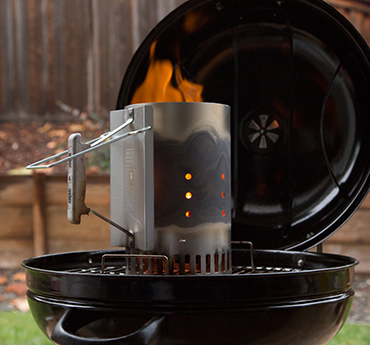- Cut:Breast
- When it's Done:74°C
Boneless, skinless chicken breasts have become a barbecuing standard. But they are also one of the easiest foods to overcook. The key to perfect boneless, skinless chicken breasts is a quick sear followed by indirect barbecuing. Follow these six easy barbecuing steps using Kingsford® Charcoal, for perfect boneless, skinless chicken breasts.

1Fire up the grill.
For barbecuing chicken breasts, you need a two-zone, medium-hot fire. Fire up a full chimney of Kingsford® Charcoal, or light a pile of about 100 briquets. When the coals are ready, arrange them in a two-zone fire. Replace the top grate, and allow the BBQ to heat up with all vents fully open. Just before placing the chicken on the grate, dip a folded paper towel in cooking oil and oil the entire grate using long-handled tongs. This will prevent the skinless breasts from sticking to the grate.- 2
Prep the chicken breasts.
Boneless skinless breasts are easy to dry out, so consider marinating or brining (use a basic brine solution of ¼ cup salt to four cups water) before cooking. If you didn’t marinate them, season them to your liking. -
3
Grilling the chicken
Place the chicken breasts on the hot side of the grate, directly above the coals. Sear the breasts for about three to four minutes per side, turning only once, until golden brown. If the BBQ flares up, temporarily move the chicken away from the coals. When the breasts are properly browned, move them to the warm, or indirect, side of the grate. Replace the lid and, if using a BBQ thermometer, bring the temperature up to 177°C. 
4Adding BBQ sauce or glaze (optional)
If you want to apply a sugar-based sauce or glaze to the chicken breasts, do it during the last 10 minutes of cooking. Slather a layer of sauce or glaze on one side of the chicken breasts, close the lid for five minutes to let the sauce bake on, then open the lid, turn the breasts, and repeat the process.- 5
Test for doneness.
There are two common methods of testing barbecued chicken breasts for doneness. The safest and surest method is to use a digital meat thermometer. Insert the tip into the thickest part of the breast and when the internal temperature reaches 74°C, remove it from the BBQ. The other option is to cut into the breast and take a look — the meat should be white, without a rubbery texture, and the juices should run clear. However, this method will release some of the juices. 
6Rest and serve.
When the chicken breasts are ready, place them on a cutting board or a platter, loosely cover them with foil, and allow them to “rest” for five minutes to allow the juices to settle back into the meat. After cooking chicken breasts on the BBQ, keep them warm until serving — at 60°C or hotter.

The marinade in which raw chicken has been soaking should never be used on cooked chicken unless it has simmered for at least 10 minutes.

Don’t put cooked chicken breasts on the same platter that held raw poultry.
 Thaw chicken in the refrigerator — never on the countertop. In a pinch, you can thaw wrapped poultry in a sink full of cold water, replenishing the water frequently.
Thaw chicken in the refrigerator — never on the countertop. In a pinch, you can thaw wrapped poultry in a sink full of cold water, replenishing the water frequently.



